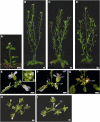Arabidopsis TERMINAL FLOWER1 is involved in the regulation of flowering time and inflorescence development through transcriptional repression
- PMID: 21890645
- PMCID: PMC3203435
- DOI: 10.1105/tpc.111.088641
Arabidopsis TERMINAL FLOWER1 is involved in the regulation of flowering time and inflorescence development through transcriptional repression
Abstract
TERMINAL FLOWER1 (TFL1) is a key regulator of flowering time and the development of the inflorescence meristem in Arabidopsis thaliana. TFL1 and FLOWERING LOCUS T (FT) have highly conserved amino acid sequences but opposite functions. For example, FT promotes flowering and TFL1 represses it; FT-overexpressing plants and TFL1 loss-of-function mutants have a similar phenotype production of terminal flowers in the shoot apex. FT is believed to function in a transcriptional activator complex by interacting with FD. Here, we demonstrate that TFL1 is involved in the transcriptional repression of genes that are activated by FT. We analyzed transgenic plants overexpressing TFL1 fused to a transcriptional repressor domain (TFL1-SRDX) or an activator domain (TFL1-VP16). Plants carrying 35S:TFL1-SRDX showed delayed flowering similar to 35S:TFL1 plants, and plants carrying 35S:TFL1-VP16 showed an early flowering phenotype and produced terminal flowers. Furthermore, the tfl1 and 35S:TFL1-VP16 plant phenotypes were strongly suppressed by the fd mutation, and TFL1 interacted with FD in the cell nucleus, as shown by bimolecular fluorescence complementation experiments. We conclude that TFL1 negatively modulates the FD-dependent transcription of target genes to fine-tune flowering time and the development of the inflorescence meristem.
Figures





Comment in
-
TERMINAL FLOWER1 acts in transcriptional repression.Plant Cell. 2011 Sep;23(9):3084. doi: 10.1105/tpc.111.230911. Epub 2011 Sep 2. Plant Cell. 2011. PMID: 21890646 Free PMC article. No abstract available.
References
-
- Abe M., Kobayashi Y., Yamamoto S., Daimon Y., Yamaguchi A., Ikeda Y., Ichinoki H., Notaguchi M., Goto K., Araki T. (2005). FD, a bZIP protein mediating signals from the floral pathway integrator FT at the shoot apex. Science 309: 1052–1056 - PubMed
-
- Alvarez J., Guli C.L., Yu X.-H., Smyth D.R. (1992). terminal flower: a gene affecting inflorescence development in Arabidopsis thaliana. Plant J. 2: 103–116
-
- Benlloch R., Kim M.C., Sayou C., Thevenon E., Parcy F., Nilsson O. (2011). Integrating long-day flowering signals: A LEAFY binding site is essential for proper photoperiodic activation of APETALA1. Plant J. 67: 1094–1102 - PubMed
-
- Blázquez M.A., Ahn J.H., Weigel D. (2003). A thermosensory pathway controlling flowering time in Arabidopsis thaliana. Nat. Genet. 33: 168–171 - PubMed
Publication types
MeSH terms
Substances
Associated data
- Actions
LinkOut - more resources
Full Text Sources
Molecular Biology Databases
Miscellaneous

